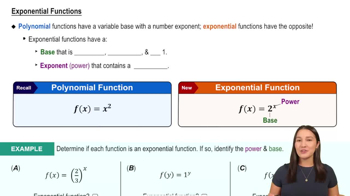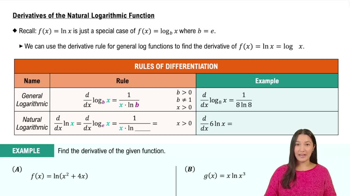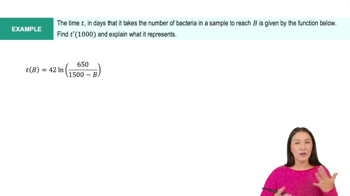Table of contents
- 0. Functions7h 52m
- Introduction to Functions16m
- Piecewise Functions10m
- Properties of Functions9m
- Common Functions1h 8m
- Transformations5m
- Combining Functions27m
- Exponent rules32m
- Exponential Functions28m
- Logarithmic Functions24m
- Properties of Logarithms34m
- Exponential & Logarithmic Equations35m
- Introduction to Trigonometric Functions38m
- Graphs of Trigonometric Functions44m
- Trigonometric Identities47m
- Inverse Trigonometric Functions48m
- 1. Limits and Continuity2h 2m
- 2. Intro to Derivatives1h 33m
- 3. Techniques of Differentiation3h 18m
- 4. Applications of Derivatives2h 38m
- 5. Graphical Applications of Derivatives6h 2m
- 6. Derivatives of Inverse, Exponential, & Logarithmic Functions2h 37m
- 7. Antiderivatives & Indefinite Integrals1h 26m
- 8. Definite Integrals4h 44m
- 9. Graphical Applications of Integrals2h 27m
- 10. Physics Applications of Integrals 2h 22m
6. Derivatives of Inverse, Exponential, & Logarithmic Functions
Derivatives of Exponential & Logarithmic Functions
Problem 3.9.56b
Textbook Question
The energy (in joules) released by an earthquake of magnitude M is given by the equation E=25,000 ⋅ 101.5M. (This equation can be solved for M to define the magnitude of a given earthquake; it is a refinement of the original Richter scale created by Charles Richter in 1935.)
Compute dE/dM and evaluate it for M=3. What does this derivative mean? (M has no units, so the units of the derivative are J per change in magnitude.)
 Verified step by step guidance
Verified step by step guidance1
First, identify the function given in the problem: \( E = 25,000 \cdot 10^{1.5M} \). This represents the energy released by an earthquake as a function of its magnitude \( M \).
To find \( \frac{dE}{dM} \), we need to differentiate the function \( E \) with respect to \( M \). Notice that the function involves an exponential term \( 10^{1.5M} \).
Apply the chain rule for differentiation. The derivative of \( 10^{1.5M} \) with respect to \( M \) is \( 10^{1.5M} \cdot \ln(10) \cdot 1.5 \). Multiply this by the constant 25,000 to get the derivative: \( \frac{dE}{dM} = 25,000 \cdot 10^{1.5M} \cdot \ln(10) \cdot 1.5 \).
Now, substitute \( M = 3 \) into the derivative \( \frac{dE}{dM} \) to evaluate it at this specific magnitude. This involves calculating \( 25,000 \cdot 10^{4.5} \cdot \ln(10) \cdot 1.5 \).
The derivative \( \frac{dE}{dM} \) represents the rate of change of energy with respect to the magnitude of the earthquake. It tells us how much the energy released by the earthquake increases for a small increase in magnitude \( M \). The units of this derivative are joules per change in magnitude.
 Verified video answer for a similar problem:
Verified video answer for a similar problem:This video solution was recommended by our tutors as helpful for the problem above
Video duration:
5mPlay a video:
Was this helpful?
Key Concepts
Here are the essential concepts you must grasp in order to answer the question correctly.
Derivative
A derivative represents the rate of change of a function with respect to a variable. In this context, dE/dM indicates how the energy E released by an earthquake changes as the magnitude M changes. It quantifies the sensitivity of energy release to variations in magnitude, providing insight into the relationship between these two variables.
Recommended video:

Derivatives
Exponential Functions
The equation E=25,000 ⋅ 10<sup>1.5M</sup> is an example of an exponential function, where the variable M is in the exponent. Exponential functions grow rapidly, and in this case, they illustrate how small increases in magnitude can lead to significant increases in energy release. Understanding the properties of exponential functions is crucial for analyzing the behavior of E as M changes.
Recommended video:

Exponential Functions
Magnitude Scale
The magnitude scale, originally developed by Charles Richter, quantifies the size of earthquakes. It is a logarithmic scale, meaning each whole number increase on the scale corresponds to a tenfold increase in measured amplitude and approximately 31.6 times more energy release. This concept is essential for interpreting the results of the derivative, as it contextualizes how energy release varies with changes in magnitude.
Recommended video:

Properties of Functions

 4:50m
4:50mWatch next
Master Derivatives of General Exponential Functions with a bite sized video explanation from Callie
Start learningRelated Videos
Related Practice














